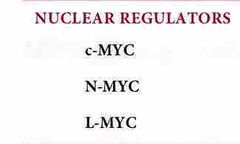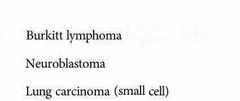![]()
![]()
![]()
Use LEFT and RIGHT arrow keys to navigate between flashcards;
Use UP and DOWN arrow keys to flip the card;
H to show hint;
A reads text to speech;
74 Cards in this Set
- Front
- Back
- 3rd side (hint)
|
Neoplasia is |
new tissue growth that is unregulated, irreversible, and monoclonal; these features distinguish it from hyperplasia and repair. |
|
|
|
Clonality was historically determined by glucose-6-phosphate dehydrogenase (G6PD) enzyme isoforms. |
Normal ratio of active isoforms in cells of any tissue is 1:1 (e.g., 50% of cells have G6PDA, and 50% of cells have G6PDB |
|
|
|
Clonality o f B lymphocytes is determined by |
immunoglobulin (Ig) light chain phenotype. |
|
|
|
Normal kappa to lambda light chain ratio is |
3:1. |
|
|
|
Ratio increases to > 6:1 or is inverted (e.g., kappa to lambda ratio = 1:3) in lymphoma, which is. |
monoclonal |
|
|
|
Benign tumors remain |
localized and do not metastasize. |
|
|
|
Malignant tumors (cancer) characteristics |
invade locally and have the potential to metastasize. |
|
|
|
Cancer is the ..... leading cause of death in both adults and children. |
Cancer is the 2nd leading cause of death in both adults and children. |
|
|
|
leading causes of death in adults are |
(1) cardiovascular disease, (2) cancer, and (3) chronic respiratory disease. |
|
|
|
The leading causes of death in children are |
(1) accidents, (2) cancer, and (3) congenital defects. |
|
|
|
The most common cancers by incidence in adults are |
(1) breast/prostate, (2) lung, and (3) colorectal. |
|
|
|
The most common causes of cancer mortality in adults are |
(1) lung, (2) breast/ prostate, and (3) colorectal. |
|
|
|
Approximately ——- divisions occur before the earliest clinical symptoms arise. |
30 |
|
|
|
Goal of screening |
catch dysplasia (precancerous change) before it becomes carcinoma or carcinoma before clinical symptoms arise |
|
|
|
Pap smear - detects |
cervical dysplasia (CIN) before it becomes carcinoma |
|
|
|
Mammography - detects |
in situ breast cancer (e.g., DCIS) before it invades or invasive carcinoma before it becomes clinically palpable |
|
|
|
Prostate specific antigen (PSA) and digital rectal exam - detects |
prostate carcinoma before it spreads |
|
|
|
Hemoccult test (for occult blood in stool) and colonoscopy - detect |
colonic adenoma before it becomes colonic carcinoma or carcinoma before it spreads |
|
|
|
Cancer formation is initiated by damage to ______ of stem cells. |
Cancer formation is initiated by damage to DNA of stem cells. |
|
|
|
Carcinogens are agents |
that damage DNA, increasing the risk for cancer. Important carcinogens include chemicals, oncogenic viruses, and radiation |
|
|
|
mutations of proto-oncogenes form ....... that lead to unregulated cellular growth. |
oncogenes |
|
|
|
Categories of oncogenes include |
growth factors, growth factor receptors, signal transducers, nuclear regulators, and cell cycle regulators |
|
|
|
Aflatoxins derived from ,and cancer association |
Hepatocellular carcinoma , |
Derived from Aspergillus, which can contaminate stored rice and grains |
|
|
Alkylating agents,cancer |
Leukemia/lymphoma ,derived from Side effect of chemotherapy |
|
|
|
Alcohol |
Squamous cell carcinoma of oropharynx and upper esophagus, and hepatocellular carcinoma |
|
|
|
Arsenic is present in cigarette smoke. |
Squamous cell carcinoma of skin, lung cancer, and angiosarcoma of liver |
|
|
|
Asbestos |
Lung carcinoma and mesothelioma Exposure to asbestos is more likely to lead to lung cancer than mesothelioma. |
|
|
|
Cigarette smoke
|
Carcinoma of oropharynx, esophagus, lung, kidney, bladder, and pancreas |
|
|
|
Nitrosamines Found in smoked foods; responsible for high rate of stomach carcinoma in Japan |
Stomach carcinoma |
|
|
|
Naphthylamine |
Urothelial carcinoma of bladder , Derived from cigarette smoke |
|
|
|
Vinyl chloride |
Angiosarcoma of liver, Occupational exposure |
|
|
|
Nickel, chromium, beryllium, or silica
|
Lung carcinoma |
|
|
|
TUMOR SUPPRESSOR GENES Are |
P53 and Rb (retinoblastoma) |
|
|
|
ERBB2 [HER2/ neu] |
Subset of breast carcinomas |
|
|
|
In response to DNA damage, ..... slows the cell cycle and upregulates DNA repair enzymes. |
P53 |
|
|
|
If DNA repair is not possible, p53 induces apoptosis. p53 upregulates ....., which disrupts Bcl2. Cytochrome c leaks from the mitochondria activating apoptosis. |
BAX |
|
|
|
One or Both copies of the p53 gene must be knocked out for tumor formation (Knudson two-hit hypothesis). |
Both |
|
|
|
Rb "holds", which is necessary for transition to the S phase |
the E2F transcription factor |
|
|
|
Rb mutation results in constitutively free ......, allowing progression through the cell cycle and uncontrolled growth of cells. |
E2F |
|
|
|
One or Both copies of Rb gene must be knocked out for tumor formation (Knudson two- hit hypothesis). |
Both |
|
|
|
Germline mutation of RB results in familial retinoblastoma (2nd hit is somatic), characterized by bilateral retinoblastoma and. |
osteosarcoma |
|
|

Front (Term) |

Back (Definition) |
|
|
|
..... is overexpressed in follicular lymphoma. |
Bcl2 |
|
|
|
....is necessary for cell immortality |
Telomerase |
|
|
|
PDGFB gene |
Astrocytoma |
|
|
|
Cancers often have ...... telomerase, which preserves telomeres. |
upregulated |
|
|
|
......(angiogenic factors) are commonly produced by tumor cells. |
FGF and VEGF |
|
|
|
Tumor cells can evade immune surveillance by downregulating expression of |
MHC class I. |
|
|
|
Immunodeficiency (both primary and secondary) increases /decrease risk for cancer. |
Increase |
|
|
|
Epithelial tumor cells are normally attached to one another by cellular adhesion molecules called??? |
(e.g., E-cadherin) |
|
|
|
Downregulation of E-cadherin leads to dissociation of attached cells in cancer
Cells attach to laminin and destroy basement membrane (collagen type IV) via collagenase. |
Cells attach to fibronectin in the extracellular matrix and spread locally. Entrance into vascular or lymphatic spaces allows for metastasis (distant spread). |
|
|
|
Lymphatic spread is characteristic of ...... |
carcinomas |
|
|
|
Hematogenous spread is characteristic of ..... |
sarcomas |
|
|
|
some carcinomas spread through hematogenously |
1. Renal cell carcinoma (often invades renal vein) 2. Hepatocellular carcinoma (often invades hepatic vein) 3. Follicular carcinoma of the thyroid 4. Choriocarcinoma |
|
|
|
.....is generally required before a tumor can be classified as benign or malignant with certainty. |
Biopsy or excision |
|
|
|
RET |
MEN 2A, MEN 2B and sporadic medullary carcinoma of thyroid |
|
|
|
Benign tumors are usually well differentiated (Fig. 3.4A). Characteristics include ....... |
1. Organized growth 2. Uniform nuclei 3. Low nuclear to cytoplasmic ratio 4. Minimal mitotic activity 5. Lack of invasion (of basement membrane or local tissue) 6. No metastatic potential |
|
|
|
Malignant tumors are classically poorly differentiated (anaplastic, Fig. 3.4B). Characteristics include ...... |
1. Disorganized growth (loss of polarity) 2. Nuclear pleomorphism and hyperchromasia 3. High nuclear to cytoplasmic ratio 4. High mitotic activity with atypical mitosis 5. Invasion (through basement membrane or into local tissue) |
1. Disorganized growth (loss of polarity) 2. Nuclear pleomorphism and hyperchromasia 3. High nuclear to cytoplasmic ratio 4. High mitotic activity with atypical mitosis 5. Invasion (through basement membrane or into local tissue) |
|
|
Keratin Tissue type |
Epithelium |
|
|
|
Vimentin Tissue type? |
Mesenchyme |
|
|
|
Desmin Tissue type |
Muscle |
|
|
|
GFAP Tissue type |
Neuroglia |
|
|
|
Neurofilament Tissue type |
Neurons |
|
|
|
PSA Tissue type |
Prostatic epithelium |
|
|
|
ER Tissue type |
Breast epithelium |
|
|
|
Thyroglobulin Tissue type |
Thyroid follicular cells |
|
|
|
KIT |
Gastrointestinal stromal tumor |
|
|
|
Chromogranin Tissue type |
Neuroendocrine cells (e.g., small cell Chromogranin carcinoma of lung and carcinoid tumors) |
|
|
|
ERBB2 [HER2/ neu] RET KIT are
|
GROWTH FACTOR RECEPTORS |
|
|
|
RAS gene family and ABL |
Are SIGNAL TRANSDUCERS |
|
|
|
RAS gene family |
Carcinomas, melanoma, and lymphoma |
|
|
|
ABL |
CML and some types of ALL |
|
|
|
Front (Term) |
Back (Definition) |
|
|
|
In response to DNA damage, .....gene slows the cell cycle and upregulates DNA repair enzymes. |
In response to DNA damage, p53 slows the cell cycle and upregulates DNA repair enzymes. |
|

